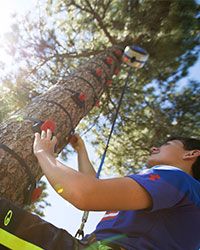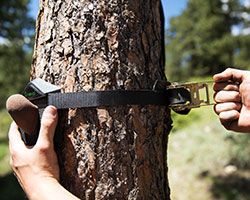Why are kids so drawn to climbing trees? Is it the challenge of ascending into the canopy? Is it the escape found when lost among the limbs? Or is it the view from new heights? It may be a combination of these reasons that draw kids to climb into the trees, and they may not even know what calls them to climb in the first place. Whatever the reason, we've created the Arboreal Tree Climbing System to allow kids (and adults!) to reach new heights and to explore more!

The Arboreal Tree Climbing System can be used to create a fun activity for a summer camp or to add an element to a ropes course or challenge course, and the system can be used on trees, poles, or column. If being placed on a tree, it's important to take time to choose the best climbing trees that are healthy and will provide the best experience possible for the climber. To get you started, we consulted with an International Society of Arboriculture (ISA) Certified Arborist for some helpful tips on choosing the best tree for your Arboreal climbing system. If there are any questions about your trees or installation, we recommend that you consult a qualified professional.
Selecting Good Climbing Trees
Before the tree-top fun can begin, you need to choose which tree (or trees) are going to support your Arboreal Tree Climbing System. Good climbing trees will be healthy and large enough to support a climber's weight. How do you know if a tree is a good candidate? Brett Stadsvold, an ISA Certified Arborist, provided some tips for picking the best tree for your Arboreal adventures. He offered the following advice:
- An ideal tree for placement of the Arboreal climbing system will have a tall, stout, and mostly vertical trunk. Look for a tree that is mostly vertical with minimal branching for easier installation.
-  Take a look in the canopy and note any broken or dead branches. Smaller limbs may be cut out with a hand saw, but larger limbs may require assistance from an arborist to clear the hazard.
- The tree should have dark green leaves or needles (a sign of good health) and a full canopy. Compare it to other trees of the same species in the area to get an idea of what a healthy canopy looks like.
- The tree should be free of cavities and decay throughout the tree. Avoid trees with cavities that nesting birds, beehives, and or other animals call home.
- Take a look at the roots. Is the ground heaving or are there mushrooms growing from the roots? Heaving ground and mushroom growth can both be signs of compromised roots.
These steps will help you start choosing the right climbing trees for your Arboreal Tree Climbing System, but remember that trees are not static. “Trees can change unexpectedly, so make sure to reevaluate a tree at least once per month and after each storm looking for broken branches, heaving ground near the roots, and cracks in the trunk and branches," said Brett. “If you have any questions about your trees, consult a professional arborist in your area." (Click here to find a certified arborist near you.)

Once you've chosen a tree or a group of trees for climbing, it's time to get started setting up your Arboreal Tree Climbing System! The prepackaged sets mean you can easily create climbing routes for many different ability levels and different tree heights and diameters. Study up on the types of climbing holds and different placements to take your route setting to the next level and to keep your climbers coming back for more. The most important tip, though, is to have fun and enjoy the view from the canopy!
